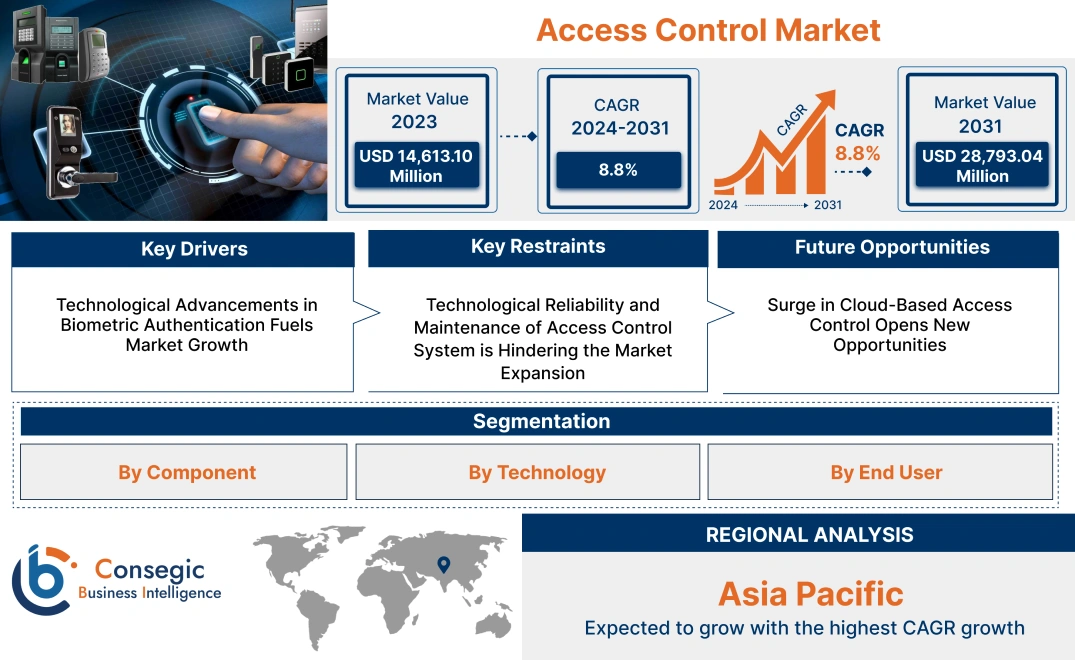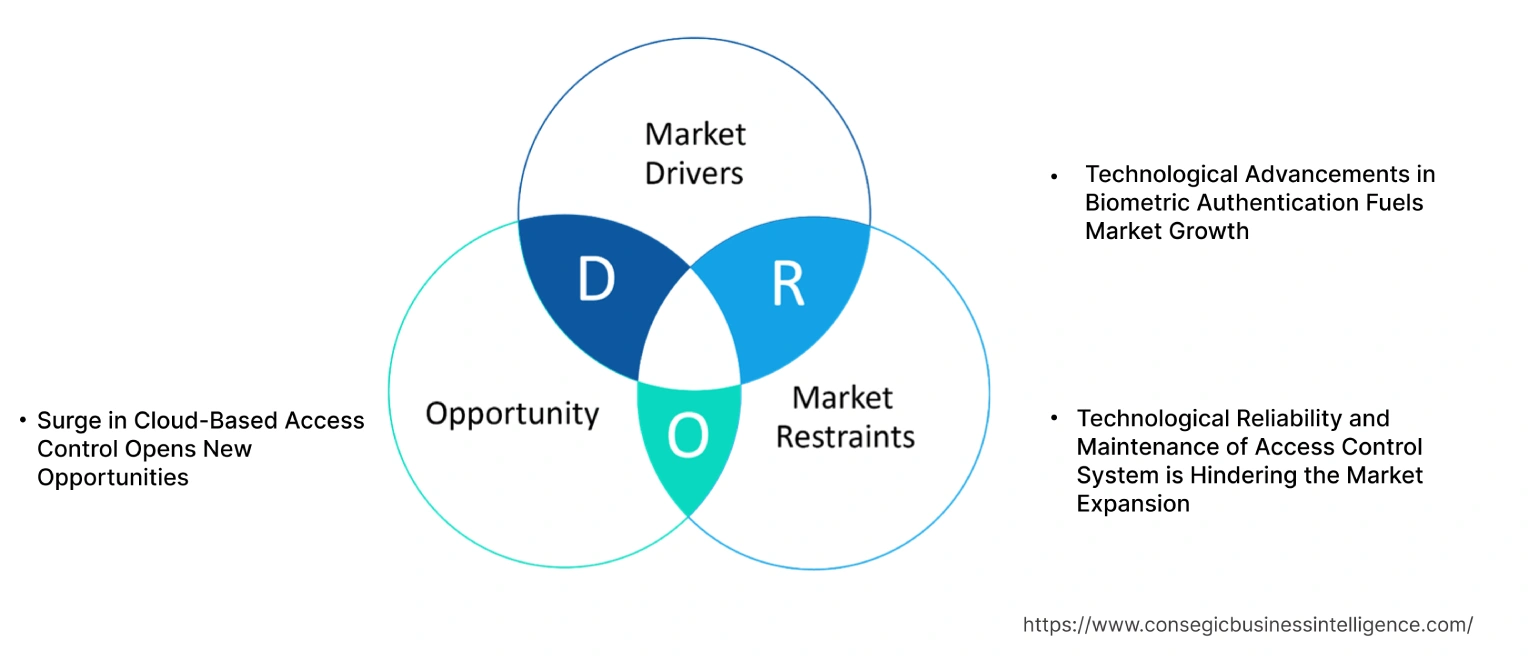- Summary
- Table Of Content
- Methodology
Access Control Market Size:
Access Control Market size is estimated to reach over USD 28,793.04 Million by 2031 from a value of USD 14,613.10 Million in 2023 and is projected to grow by USD 15,645.66 Million in 2024, growing at a CAGR of 8.8% from 2024 to 2031.
Access Control Market Scope & Overview:
Access control refers to the data security process of determining who is allowed to enter or use resources within a system, building, or network. It involves verifying identities, granting permissions, and restricting access based on predefined policies. The main purpose of this control is to protect sensitive information, assets, or areas by ensuring that only authorized individuals or devices gain entry. It involves a combination of identification, authentication, and authorization processes to verify users' identities and determine the level of access they have. Moreover, this system is essential for organizations to protect their physical premises, critical data, and internal networks from unauthorized access, theft, or cyber-attacks. The aforementioned benefits of these controls are major determinants for increasing their deployment in commercial buildings, residential, government, healthcare, and other industries.
Access Control Market Insights:
Key Drivers:
Technological Advancements in Biometric Authentication Fuels Market Growth
Technological advancements are transforming the access control market, enabling organizations to implement more sophisticated, safe, and user-friendly solutions. A higher level of security is offered by biometric authentication compared to traditional keycards or passwords. Biometrics uses unique physical traits such as fingerprints, facial features, retina patterns, and voice recognition to authenticate individuals. This makes it nearly impossible for unauthorized personnel to bypass these systems. Facial recognition has been widely adopted in airports, hospitals, and corporate offices because of its reliability in preventing security breaches. It also allows employers to monitor employee access and attendance more effectively by integrating biometric solutions with time and attendance systems.
- In May 2023, Hikvision launched the MinMoe DSK1T320 Series Attendance and Control Access Terminal with Face Recognition function for instant touch-free control and time attendance applications. Furthermore, the advanced Deep Learning algorithm is making the Touch-Free Control experience easier and smarter.
Therefore, advancements in biometric authentication are driving the access control market growth.
Key Restraints :
Technological Reliability and Maintenance of Access Control System is Hindering the Market Expansion
Cloud-based control systems are known for their benefits including scalability and management from afar; they come attached with several daunting factors of reliability. The internet connection and data centers are involved in cloud services. The disruptions to service due to network issues or server downtime will affect how the control system works or its ability to be reached. Moreover, backup servers together with disaster recovery plans are generally applied by these providers to deal with this uncertainty. Organizations tend to invest heavily in a strong secure network infrastructure so that it aids the cloud-based services.
Additionally, mobile phone applications are at times employed for control access which allows valid credentials through smartphones so, continuous upgrades should be done, mainly focusing on hardware platforms and operating software compatibility issues. Hence, as per the analysis, technological reliability and maintenance of these systems are restraining the access control market demand.
Future Opportunities :
Surge in Cloud-Based Access Control Opens New Opportunities
Organizational management and security are undergoing a revolution due to the popularity of cloud-based control solutions. Cloud-based control systems incorporate flexibility, scalability, and cost-effectiveness, addressing both present and subsequent challenges successfully as businesses increasingly integrate such technologies. Via web interfaces, they help organizations manage security remotely enabling administrators to control access points, watch activities, and even change permissions irrespective of distance. Additionally, the trend of remote working arrangements or employees who work from multiple locations intermittently visiting company premises propels the demand for cloud-based solutions.
Moreover, cloud-based control systems provide seamless integration with other digital platforms, including identity management systems, video surveillance, and building management systems. This integration allows for a unified approach to security management, where different components work together to enhance overall safety and efficiency.
- In September 2023, Johnson Controls launched its OpenBlue Service Cloud Control Access suite, designed to help businesses manage their security infrastructure remotely. This cloud solution integrates control access with building management systems, offering a unified platform for managing security, energy efficiency, and building automation. The suite is equipped with real-time analytics, allowing companies to monitor and control entry points across multiple locations, making it especially appealing for organizations with distributed workforces.
Thus, as per the analysis, the rising adoption of cloud-based control for the demand of enhanced security with remote access is proliferating the global access control market growth.
Access Control Market Segmental Analysis :
By Component:
Based on components, the market is trifurcated into hardware, software, and service.
Trends in the component:
- Modern control access hardware including readers and sensors, is increasingly integrating multiple authentication methods (e.g., biometrics, smart cards, mobile credentials) into a single device. This trend enhances flexibility and security by allowing users to choose their preferred method of access.
- There is a growing adoption of managed and hosted services including Access Control as a Service (ACaaS), which offers subscription-based models for control access management. This trend reduces the need for upfront investments in hardware and software, providing organizations with a scalable and cost-effective solution.
The hardware component segment accounted for the largest revenue share of 53.29% in 2023.
- Hardware components include control readers, sensors, and locks for physical security.
- It offers a wide range of customization options and integration possibilities with other security systems.
- Additionally, advancement in biometric hardware including facial recognition, fingerprint scanners, and IoT devices provides enhanced security and integration capabilities.
- In October 2023, Hikvision Digital Technology launched the latest range of control access terminals, including the DS-K1T671TMFW fingerprint and facial recognition terminal. Incorporated with a 7-inch LCD touch screen, 2 Megapixel wide-angle lens, built-in M1 card reading module, Max. 50,000 faces capacity, Max. 5000 fingerprints capacity, and Max. 50,000 cards. These devices are designed for high-security environments, offering advanced biometric verification and integration with existing security systems.
- Thus, biometric hardware facial recognition and fingerprint scanners are propelling the access control market demand.
The software component segment is anticipated to register the fastest CAGR during the forecast period.
- Software component includes cloud-based solutions, advanced analytics and Artificial intelligence, and integration with other systems.
- Software solutions features to help organizations standardize data security and privacy. This included advanced encryption, access logs, and audit trails to ensure compliance and protect sensitive information.
- Additionally, cloud-based control software offers significant advantages in terms of scalability and flexibility.
- In March 2021, Genetec released the Security Center 5.10 version with additional cloud-based control access functionalities and improved integration with other security systems. It provides configuration flexibility, reporting capability, on-demand video footage stored in the cloud, and encryption to ensure maximum security.
- Hence, according to analysis, flexibility and seamless integration of software components with enhanced security are fueling the global access control market opportunities.
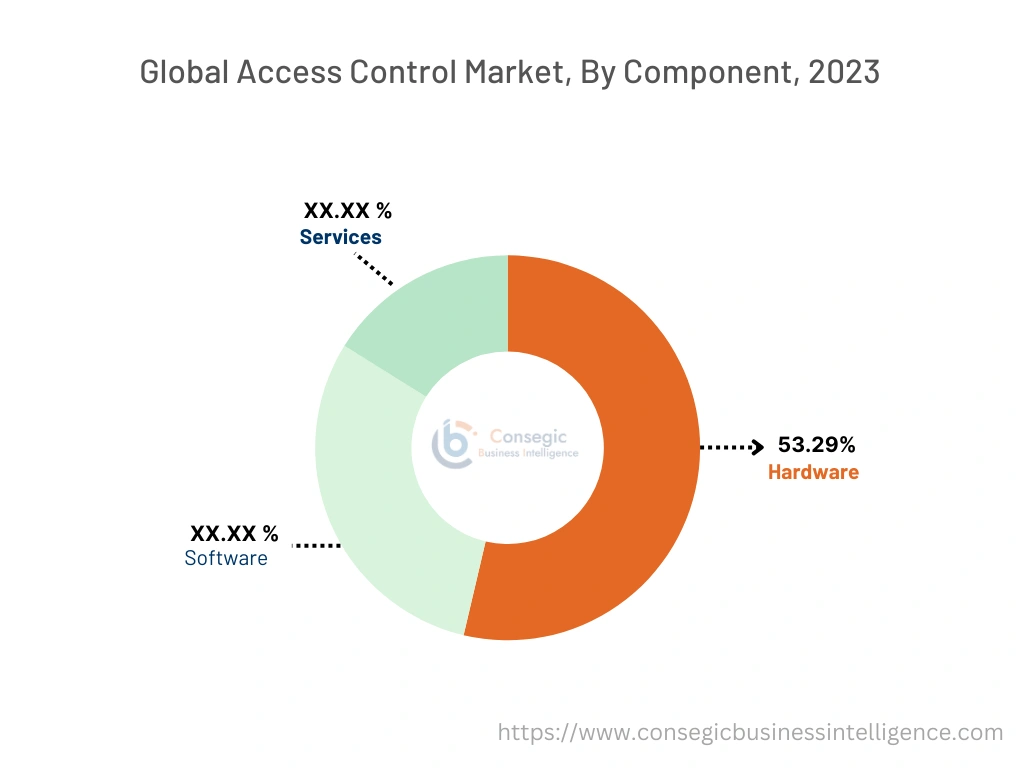
By Technology:
Based on technology, the market is segmented into biometric-based, card-based, mobile and cloud-based, and others.
Trends in the technology:
- Card-based systems are increasingly being integrated with other security solutions including video surveillance and alarm systems, creating a more comprehensive security ecosystem. This integration improves real-time monitoring and threat detection capabilities.
- Cloud-based control systems offer centralized management of multiple locations, real-time updates, and the ability to monitor and control access remotely. The trend to shift to cloud platforms is driven by the need for scalability, easier maintenance, and reduced hardware costs.
The biometric-based technology segment accounted for the largest revenue share in the year 2023.
- Biometric-based technology is defined as the use of unalterable personal characteristics including fingerprints, retina patterns, voice, or hand geometry for authentication purposes.
- This technology is used in various sectors requiring high levels of security including government, financial institutions, and healthcare. The growing demand for secure and convenient authentication solutions in these sectors are reason for the technology's adoption.
- In January 2022, IDEMIA introduced a MorphoWave Compact biometric system for secure control access in buildings. The touchless fingerprint scanning technology allows users to authenticate their identity with a simple hand wave, reducing physical contact and enhancing hygiene.
- Therefore, the rising adoption of biometric-based technology in various sectors as a security solution is boosting the access control market share.
The cloud-based technology segment is anticipated to register the fastest CAGR during the forecast period.
- Cloud-based technology enables organizations to store and access data over the internet.
- Features include flexibility, remote access, cost-effectiveness, and advanced security making cloud-based control poised for adoption.
- In April 2021, Flexential launched Hosted Private Cloud, an advanced access solution, providing customers full control over the cloud environment and VMWare vCenter management. This solution enhances business agility by enabling remote access to the tools and cloud infrastructure.
- Consequently, as per the analysis the combination of flexibility and remote accessibility of resources with enhanced security collectively fuel the access control market trend.
By End User:
Based on End-users, the market is segmented into commercial, residential, government & defense, healthcare, education, industrial, and others.
Trends in the end-user :
- Educational institutions are implementing campus-wide control systems that integrate with other security measures including surveillance cameras and emergency notification systems. This trend of integration enhances overall campus security and provides a safer environment for students and staff.
- Government buildings and critical infrastructure are adopting advanced control systems with features such as multi-factor authentication, real-time threat detection, and automated response capabilities. These systems are designed to protect sensitive information and infrastructure from potential threats.
The commercial segment accounted for the largest revenue share in 2023 and is anticipated to register the fastest CAGR during the forecast period.
- The commercial sector including offices, financial institutions, and corporate enterprises, is increasingly adopting control access as a service to manage access to the facilities efficiently.
- Additionally, the integration of these control systems with business operations and IT infrastructure is more prevalent in the commercial sector. This integration enhances overall security and streamlining operations with physical security management.
- In December 2022, Hexagon AB's acquisition of Qognify aimed to bolster security and control access solutions for the commercial sector, by integrating Qognify's software with Hexagon's digital reality solutions.
- Hence, as per the analysis, the adoption of these controls in the commercial sector is proliferating the global access control industry.
Regional Analysis:
The regions covered are North America, Europe, Asia Pacific, the Middle East and Africa, and Latin America.
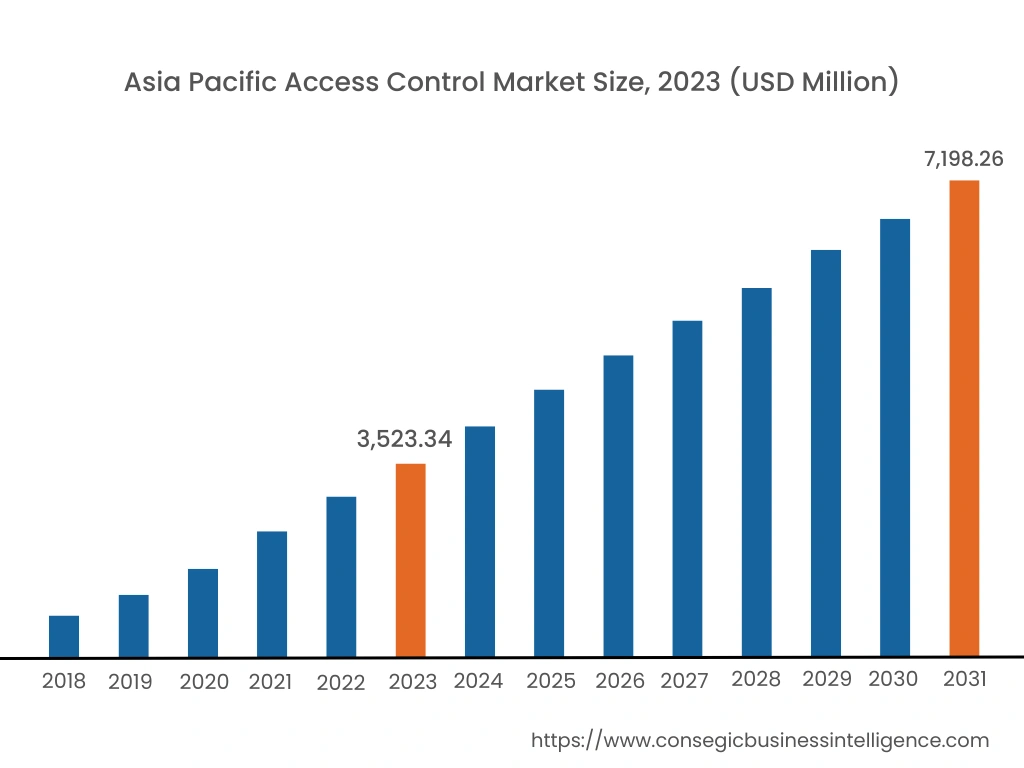
Asia Pacific region was valued at USD 3,523.34 Million in 2023. Moreover, it is projected to grow by USD 3,783.89 Million in 2024 and reach over USD 7,198.26 Million by 2031. Out of this, China accounted for the maximum revenue share of 29.4%. According to the access control market analysis, the Asia-Pacific is experiencing significant market growth. Driven by urbanization, industrialization, and rising security concerns, the access control market is expanding rapidly, with increasing investments in infrastructure and smart technologies. Additionally, the region is witnessing a growing adoption of advanced control technologies, including biometric systems, mobile credentials, and cloud-based solutions. This adoption is supported by the region's technological advancements and increasing focus on modernizing infrastructure.
- In November 2022, NEC Corporation (Japan) released a multimodal biometric authentication solution. This solution combines NEC's face recognition and iris recognition. Moreover, it enables high-speed, high-precision authentication with a false acceptance rate of less than one in 10 billion.
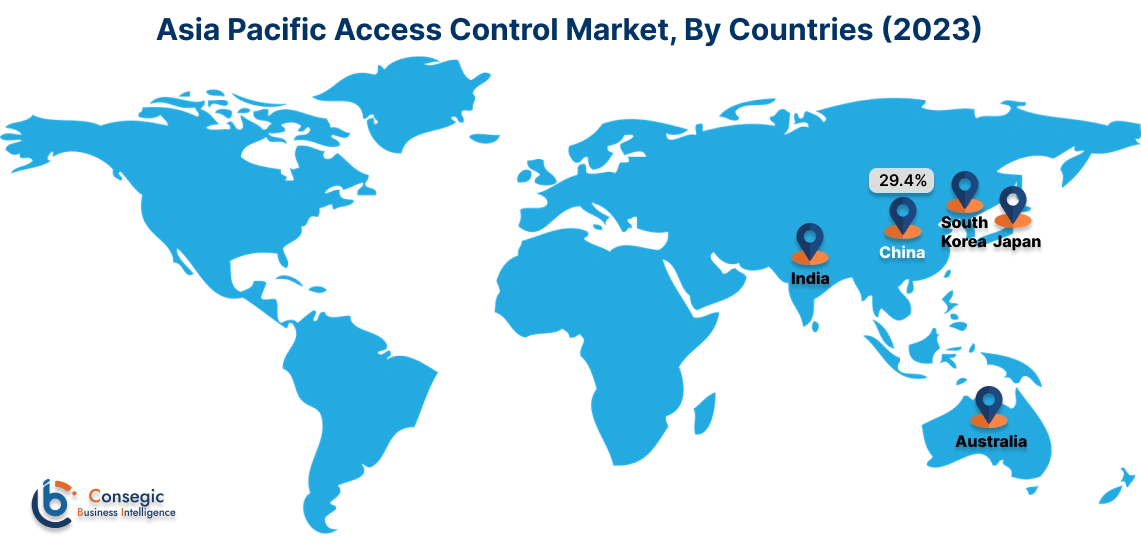
North America is estimated to reach over USD 9,562.17 Million by 2031 from a value of USD 4,851.67 Million in 2023 and is projected to grow by USD 5,194.61 Million in 2024. The region's advanced technology infrastructure, stringent security standards, and substantial investments in smart solutions contribute to its dominance. Technological advancements including biometric solutions cloud-based control, and IoT-enabled systems are the main reasons for the dominance.
- In November 2023, Amazon Web Service (AWS) (US) announced several enhancements and new services, including security innovations for public cloud infrastructure, highlighting continuous expansion and emphasis on secure, scalable cloud-based access solutions for enterprises.
Europe holds a significant share of the global access control market, driven by stringent regulatory requirements, emphasis on security, and growing adoption of advanced technologies.
Latin America is expected to see continued growth in the access control market growth, propelled by increasing urbanization , infrastructure development, and a growing focus on security.
The Middle East and Africa are emerging access control markets, with growth fueled by investments in infrastructure, smart city projects, and a focus on enhancing security. While the adoption of advanced access control technologies is growing, it is currently less widespread compared to more developed regions.
Top Key Players & Market Share Insights:
The access control market is highly competitive with major players providing advanced security systems to the national and international markets. Key players are adopting several strategies in research and development (R&D), product innovation, and end-user launches to hold a strong position in the access control market. Key players in the access control industry include-
- HID Global Corporation (US)
- Johnson Controls Inc (US)
- ASSA ABLOY (Sweden)
- Dahua Technology (China)
- Hikvision (China)
- Bosch Security Systems (Germany)
- Genetec Inc. (Canada)
- Honeywell International Inc. (US)
- Brivo (US)
- AMAG Technology (US)
- Allegion (Ireland)
- Nippon Steel (Japan)
- Toshiba (Japan)
Recent Industry Developments :
Product Launch:
- In July 2024, Dahua Technology launched DSS Professional V8.5 the latest upgrade of its industry-leading security management software. This new version is designed to simplify security management with advancements in user interface, interactive AR monitoring, deeper integration, enhanced access management, and more adjusted for various industries as they change over time.
- In February 2024, Hikvision released NVR 5.0, which is an intelligent platform that incorporates various case app applications leading to a shift from conventional recording devices to AIoT (Artificial Intelligence of Things) NVR. It also enables smart audio-video linking for quick responses and data retention apart from supporting alarm, control, and other access channels such as AIoT applications hence making it possible to run these systems from one point.
- In January 2024, Honeywell launched Advance Control for Buildings to streamline building management and establish a solid energy efficiency plan. Advance Control merges cutting-edge technologies with years of innovation and expertise in the field. Automation and machine learning enhance an efficient operating system with integrated cybersecurity and technology for quicker network speeds, utilizing existing wiring in a groundbreaking industry approach.
Announcements:
- In April 2024, Genetac Inc. announced the availability of Security Center SaaS. It is a highly scalable, open, and unified software as a service (SaaS) solution, which combines access control video management, forensic search, intrusion monitoring, automation, and other advanced security capabilities.
Access Control Market Report Insights :
| Report Attributes | Report Details |
| Study Timeline | 2018-2031 |
| Market Size in 2031 | USD 28,793.04 Million |
| CAGR (2024-2031) | 8.8% |
| By Component |
|
| By Technology |
|
| By End-User |
|
| By Region |
|
| Key Players |
|
| North America | U.S. Canada Mexico |
| Europe | U.K. Germany France Spain Italy Russia Benelux Rest of Europe |
| APAC | China South Korea Japan India Australia ASEAN Rest of Asia-Pacific |
| Middle East and Africa | GCC Turkey South Africa Rest of MEA |
| LATAM | Brazil Argentina Chile Rest of LATAM |
| Report Coverage |
|
Key Questions Answered in the Report
What is Access Control? +
Access control refers to the data security process of determining who is allowed to enter or use resources within a system, building, or network. It involves verifying identities, granting permissions, and restricting access based on predefined policies.
How big is the Access control market? +
Access Control Market size is estimated to reach over USD 28,793.04 Million by 2031 from a value of USD 14,613.10 Million in 2023 and is projected to grow by USD 15,645.66 Million in 2024, growing at a CAGR of 8.8% from 2024 to 2031.
What is the key market trend? +
There is a growing adoption of managed and hosted services including Access Control as a Service (ACaaS), which offers subscription-based models for access control management. This trend reduces the need for upfront investments in hardware and software, providing organizations with a scalable and cost-effective solution.
Who are the major players in the access control market? +
Key players in the access control industry include HID Global Corporation (US), Johnson Controls Inc (US), Honeywell International Inc. (US), ASSA ABLOY (Sweden), Dahua Technology (China), Hikvision (China), Bosch Security Systems (Germany), Genetec Inc. (Canada), Brivo (US), AMAG Technology (US), Allegion (Ireland), Nippon Steel (Japan), Toshiba (Japan) and others.
